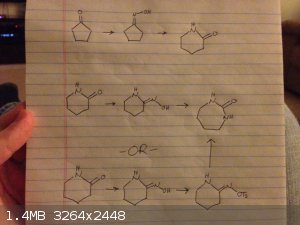Leo Szilard
Harmless

Posts: 20
Registered: 10-5-2015
Location: USA
Member Is Offline
Mood: No Mood
|
|
Sequential Beckmann Rearrangement?
I was wondering if you can perform sequential Beckmann rearrangements. For example, with cyclopentanone as the starting material, you can get to a
δ-lactam. Can this undergo another Beckman rearrangement to yield 1,3-diazepan-2-one? I can't seem to find much about this compound. Is this compound
unstable? Or is there a common name?
This idea seems obvious, so I can't believe it hasn't been attempted. Maybe the acidic conditions required for the rearrangement causes the δ-lactam
to open up. If this is the case, do you think the second ring expansion could be done under milder conditions (maybe with an OTos leaving group)?

|
|
|
byko3y
National Hazard
   
Posts: 721
Registered: 16-3-2015
Member Is Offline
Mood: dooM
|
|
Amide is not a ketone.
|
|
|
Leo Szilard
Harmless

Posts: 20
Registered: 10-5-2015
Location: USA
Member Is Offline
Mood: No Mood
|
|
Search for "azepan-2-one". I didn't invent nomenclature.
Or "Hexahydro-2H-azepin-2-one". Or "Hexahydro-2H-azepine-2-one"
[Edited on 28-5-2015 by Leo Szilard]
|
|
|
CuReUS
National Hazard
   
Posts: 928
Registered: 9-9-2014
Member Is Offline
Mood: No Mood
|
|
I think this is the reason why what you are suggesting doesn't happen
in the beckmann-rearrangement,you initially convert a ketone into a ketoxime by reacting it with hydroxylamine.in the mechanism,the carbonyl carbon
gets a positive charge.but when there is already an N atom next to it(like in an amide),the positive character will obviously be less(due to lone pair
donation by N).So hydroxylamine will not react with it at all to form an oxime,and without the oxime,no beckmann 
byko was't complaining about nomenclature.He just said it in one line 
[Edited on 28-5-2015 by CuReUS]
|
|
|
Leo Szilard
Harmless

Posts: 20
Registered: 10-5-2015
Location: USA
Member Is Offline
Mood: No Mood
|
|
Thanks. Yeah I get the "amide is not ketone" comment now. Thank you! I wasn't thinking.
|
|
|
Nicodem
Super Moderator
      
Posts: 4230
Registered: 28-12-2004
Member Is Offline
Mood: No Mood
|
|
Amidoximes can rearrange to ureas, but the rearrangement is called the Tiemann rearrangement and is analogous to the Lossen rearrangement of
hydroxamic acids rather than the Beckmann rearrangement (for this reason it requires activation, generally by O-sulfonylation, and a basic medium).
Amidoximes can be prepared from amides, but not directly with hydroxylamine as the aldoximes and ketoximes. Instead, amides are generally activated by
forming the chloroimidate (e.g., with oxalyl chloride) and then acylating hydroxylamine with it.
…there is a human touch of the cultist “believer” in every theorist that he must struggle against as being
unworthy of the scientist. Some of the greatest men of science have publicly repudiated a theory which earlier they hotly defended. In this lies their
scientific temper, not in the scientific defense of the theory. - Weston La Barre (Ghost Dance, 1972)
Read the The ScienceMadness Guidelines!
|
|
|
Leo Szilard
Harmless

Posts: 20
Registered: 10-5-2015
Location: USA
Member Is Offline
Mood: No Mood
|
|
Thanks! I'll check it out.
|
|
|
byko3y
National Hazard
   
Posts: 721
Registered: 16-3-2015
Member Is Offline
Mood: dooM
|
|
As far as I can see, Schmidt, Hofmann, Beckmann, Lossen and Tiemann rearrangements all go through the same mechanism of nitrene formation https://en.wikipedia.org/wiki/Nitrene , the latter can also be made by oxidation of carbamate with persulfate, and nitrene is known to be capable
of addition to carbon.
While Schmidt, Lossen and Hofmann go through isocyanate intermediate after nitrene rearrangment, Tiemann goes via cyanamide, while Beckmann goes via
nitrile, thus being slightly distinctive from others because electronegative atom is absent on carbon side (but the nitrile intermediate is still
positively charged).
|
|
|
CuReUS
National Hazard
   
Posts: 928
Registered: 9-9-2014
Member Is Offline
Mood: No Mood
|
|
Quote: Originally posted by Nicodem  |
Amidoximes can be prepared from amides, but not directly with hydroxylamine as the aldoximes and ketoximes. Instead, amides are generally activated by
forming the chloroimidate (e.g., with oxalyl chloride) |
I read somewhere that NaBH4 could reduce amides to amines,in the presence of an acidic reagent.(I may be wrong,but I am guessing the
"acidic reagent" is POCl3,I remember reading an article on that)So could amides be reduced by NaBH4 if the chloroimidate was
formed first?
|
|
|